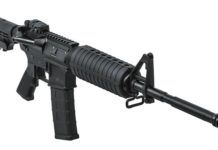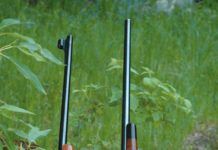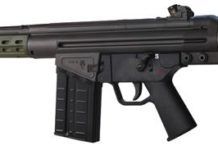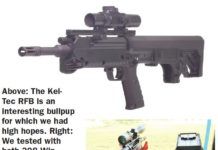Ruger Collector’s Series 10-22 Carbine
Sturm, Ruger & Company has announced the Second Edition of the Ruger Collector's Series 10/22 Carbine. The first Collector's Edition sold out quickly.
How About a Krag-Jorgensen?
The Krag-Jorgensen rifle was invented by Capt. Ole Krag and Erik Jorgensen in Norway in the late 1800s. Denmark adopted the design first, in 1889, preceding Norway's acceptance of it in 1894. The Danes had it chambered for the 8x58R cartridge and used it until at least 1940. The first Norwegian cartridge for this rifle was identical to that which has become known as the 6.5x55 Swedish, but the proof-testing cartridges were of lower pressure than those used later in the history of the 6.5x55. Krag ammunition manufactured in this country is limited to about 40-42,000 psi, well within the rifle's capabilities.
By 1890 every major power in the world had a bolt-action rifle for its military services except the United States. After deliberation over more than 50 entries, in 1892 the U.S. decided on the Norwegian Krag-Jorgensen, with a few modifications, as a replacement for the single-shot 1873 "trapdoor" Springfield with its 45-70 black-powder cartridge. According to Frank De Haas in Bolt Action Rifles, 3rd Edition (1995), as finally adopted and produced at Springfield Arsenal, the Krag fired a 200-grain round-nose bullet at a velocity of around 2000 fps. The Krag was used by the U.S. Army in the Spanish-American war of 1898, as was the old 1873 Springfield. The U.S. Navy used the Lee 6mm rifle in that conflict. The Krag rifle saw action in a few other conflicts in U.S. hands as well, but was quickly replaced by the 1903 Springfield 30-06. Although its military life with U.S. forces was short, it saw service up until at least WWII in other nations.
The Krag had its limitations. It could not be stripper-clip loaded, though the infantryman could top off the five-shot magazine without opening the bolt. Each cartridge should be inserted so the rim of the next one would be behind the preceding one, though the Krag's magazine lines them up perfectly all by itself as you close the box. In fact we were unable to intentionally foul the loading process. The Krag's ballistics were a good step behind those of the majority of other countries' rifles at the turn of the century. However, the rifles were well made and turned out to be mighty sturdy despite the so-called limitation of having only one bolt lug. We tested our sample with Remington 180-grain PSP Core-Lokt and with HSM (Montana) 165-grain soft-point boattails. Here's what we found.
3rd Circuit Rules for Wal-Mart Stocking AR-15s
In a review of a recent court case, the Third Circuit Court of Appeals has released its full opinion in the case of Trinity Wall Street v. Wal-Mart, and it's a victory for the giant retail chain's ability to sell the firearms it wishes to sell.
At issue was whether Wal-Mart improperly excluded from 2014 proxy materials the church's shareholder proposal to require the corporation's board of directors to have standard-capacity AR-style rifles removed from the…
AR-15 Models Head to Head: CMMG and Battle Rifle Co.
It isn't unusual for a dozen AR-15 rifles from different makers to be on the shelf at most gun shops. Some are regional makers, some are giants like Colt, and a few are new companies trying to earn a good name for themselves. The modular construction of the AR-15 means that the basic receiver may be fitted with a number of different barrel types, stock designs, and other accessories. As such, the price point is flexible, depending upon whether the user wants an entry-level rifle or something more. We picked the rifles in this report to see if the details and accessory package on a more expensive rifle really offered enough performance to justify the extra money. There are literally dozens of choices to make between rifles in this price zone, so as much as anything, this was a test of accessories and set-up, culminating in our advice on how to buy an AR that's a flexible platform for growth as possible.
Savage Introduces A17 Semi-Auto in 17 HMR
Savage Arms Introduces the A17 Semi-automatic Rifle in 17 HMR
338 Win. Mag. Bolt-Action Duo: Henriksen Versus Winchester
The gunny student who knows anything at all about Elmer Keith will probably know many of Keith's guns were sold off recently by a well-known auction house in Maine. Apparently, the auction was a huge success, and some of the offerings proved to be bargains. A brace of like-new Ruger No. 1 rifles sold for less than their combined new MSRP prices today, and a fabulous engraved and gold-inlaid Model 70 made by Frank Pachmayr for Elmer Keith sold for less than some unadorned custom rifles made by some makers on today's market.
Among the auctioned rifles were several by Keith's favorite gunsmith, Iver Henriksen (1910-1987). In fact, our Senior Technical Editor made a solid absentee bid for one of the Henriksen-Keith rifles. Alas, the rifle sold for three times that bid. From this auction, we discovered that if a rifle has Henriksen's name on it, especially if it was owned by Keith, it will have a value of about $5000; but of course that's not guaranteed. So we thought we had lost out on the chance to examine and test a Henriksen rifle. As luck had it, however, a friend of the magazine owned one of Henriksen's rifles, but didn't know it. We were talking with him one day and he said he had a rifle made by some Montana gunsmith. We asked if it could possibly be a Henriksen rifle, and he said he didn't know. When we got a chance to examine it, we saw the Henriksen name written around the base of the barrel, and explained to our friend what he had.
He graciously allowed us to borrow it for this report. He later found out the design and layout of this particular rifle in all its aspects had in fact been suggested by Mr. Keith to its previous owner. The rifle is a custom FN Mauser 98 in 338 Winchester Magnum with fabulous wood, and it is fitted with a classic Balvar 8A Bausch & Lomb 2.5-8X scope with the windage and elevation adjustments in the bases.
We chose to test it against a modern Winchester Model 70 in the same caliber, the rifle having also just been fitted with one of the old B&L Balvar 8A 2.5-8X scopes in adjustable-base mounts. We tested this rifle in the December 2012 edition of Gun Tests where it got high marks (A-). The Model 70, now owned by our Senior Technical Editor, got some serious upgrading, which put it into the realm of the Henriksen for its ability to handle long-seated bullets. Here's what we found.
Springfield Armory Releases Flat Dark Earth Color For M1A Rifle and XD-S Pistol
Springfield Armory is introducing a Flat Dark Earth (FDE) color-tone variant in several categories, starting with the M1A Loaded Precision Adjustable Stock Rifle and the XD-S 3.3-inch pistol in 9mm and .45 ACP chamberings.
Armalite AR-10 National Match Rifle and M-15 A4 National Match Special Purpose Rifle
If you plan on attending the 2015 National Matches at Camp Perry, Ohio, look for two National Match rifles made by Armalite that seem pretty popular.
308 Win. Battle Rifle Shoot Out: Century Arms C91 Vs. PTR-91
The roller-locked CETME Model 58 was the basis for Heckler & Koch's G3-based rifles, followed some time later by a semiautomatic version labeled the HK-91, which isn't gas- or recoil-operated in the conventional sense. The rifle employs a delayed blowback system with a nonrotating head and twin rollers. These rollers, located on the bolt on each side, lock into detents in the trunnion of a stamped steel receiver.
On firing, force on the bolt keeps the action locked until the bullet exits the barrel, then the action unlocks and the bolt is jolted to the rear against spring pressure. The bolt then returns to battery, stripping a cartridge from the magazine along the way. We have previously tested three roller-locked rifles made in the U.S., including the 308 Win. PTR-91 from JLD Enterprises. We mostly praised the PTR-91 rifle in the January 2005 issue, save it needing a trigger job and a flash hider. We also gave Buy recommendations to the Vector Arms V-53 in 5.56 NATO and the Bobcat Weapons BW-5 9mm in that same article.
Here, we revisit the PTR-91 and a similar rifle, the Century Arms C91 Sporter, both chambered in 308 Win./7.62 NATO. The original PTR rifle was first conceived in 2002, when JLD Enterprises purchased tooling and designs for the HK line of roller-lock weapons from Fabrica Militar of Portugal. The original "Precision Tactical Rifle" HK-91 clones were produced mostly from surplus parts acquired around the world from 2002 to 2006. Then, in 2006, PTR91 Inc. was organized and expanded beyond the original 91-style clones. The company was re-organized in 2010 with new management, and then three years later, PTR Industries made news when it announced it was leaving Bristol, Connecticut and was moving to South Carolina because of the former state's just-passed stringent gun-control laws.
Century Arms, headquartered in Delray Beach, Florida, makes and warehouses its surplus firearms and accessories business in Georgia, Vermont. Founded in the 1960s and run by William Sucher and Manny Weigensberg, Century is the largest importer of Romanian-made WASR-10 AK variants. The C91 has been supplanted in the Century Arms catalog by the C308 rifle.
So, no surprise — accurate, powerful, and well-made 308-Win. semi-auto rifles remain strong sellers. The question we wanted to know is, do shooters have to pay a premium to get one of these roller-locked mechanisms? The short answer is "No," but the longer answer appears below:
Disappointing: Kel-Tecs RFB 7.62 Forward-Ejecting Bullpup
With much hype and anticipation, we took Kel-Tec CNC's RFB forward-ejecting bullpup rifle to the range 18 months ago to compare it with other bullpup-style rifles we've reviewed. This being the only 30-caliber bullpup we've tested so far, most of our shooters were eager to get behind the scope and send rounds downrange. Taking any bullpup to the range always draws some attention, and the Kel-Tec RFB was no different. The gun has a striking overall appearance, especially with the Nikko-Sterling 3-10x42 Nighteater scope we mounted on ours.
Ruger Mini 14 Tactical Rifle Now Available in 300 Blackout
Sturm, Ruger has announced that the Mini-14 Tactical rifle is now available in 300 AAC Blackout. Suggested retail is one thousand and nineteen dollars.
This chambering should be interesting to Ruger shooters who want an AR-length round that can operate with both supersonic ammunition and subsonic ammunition, the latter for suppressed use.
Because of the 300 Blackout's bullet-weight range, it's easier to make a round that stays below 1100 fps but still has plenty of downrange energy.
IWI Galil ACE 2015 SHOT Show
After a lull of almost 25 years, IWI US is bringing back the Galil ACE family of pistols and rifles to the US commercial/civilian market.
The modernized Galil ACE is based upon the original Galil assault rifle first developed by IMI in the late 1960s. It has elements of the Russian AK-47 and the Finnish Valmet RK 62.




































